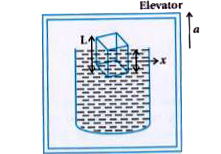A cubical block of density ρ is floating on the surface of water .Out of its height L, fraction x is submerged in water . The vessel is in an elevator accelerating upward with acceleration a . What is the fraction immersed ?Solution in Gujrati
Let density of water is ρw. A block of height L float on it .x be the height of block submerged in water .
Volume of block V=L3
Mass of block m=Vρ=L3ρg
Weight of the block =mg=L3ρg

First Case : Volume of part of cube submerged in water =xL2
∴ Weight of water displaced by block =xL2ρwg
Weight of block =weight of water displaced by block .
L3ρg=xL2ρwg
∴xL=ρρw
∴x=ρρwL....(1)
Second Case : When vessel is placed in an elevator moving upward with acceleration a , then effective acceleration =g=(g+a)
More acceleration a is due to Pseudo force
∴ Weight of block =mg
=m(g+a)
Suppose , and elevator is moving upward .Let new fraction of block submerged in water is x1
For floating of block ,
Weight of block =Weight of displaced water ,
L3ρ(g+a)=x1L2ρw(g+a)
∴x1L=ρρw....(2)
x1=ρρw⋅L
From equation (1)and (2) ,
x=x1
Hence , the fraction of the block submerged is independent of acceleration.
Topper's Solved these Questions
- MECHANICAL PROPERTIES OF FLUIDS BOOK - KUMAR PRAKASHANCHAPTER - MECHANICAL PROPERTIES OF FLUIDS EXERCISE - SECTION - (D NCERT Exemplar Solution) (Short Answer Type Questions
5 Videos
- MECHANICAL PROPERTIES OF FLUIDS BOOK - KUMAR PRAKASHANCHAPTER - MECHANICAL PROPERTIES OF FLUIDS EXERCISE - SECTION - (D NCERT Exemplar Solution) (Long Answer Type Questions
3 Videos
- MECHANICAL PROPERTIES OF FLUIDS BOOK - KUMAR PRAKASHANCHAPTER - MECHANICAL PROPERTIES OF FLUIDS EXERCISE - SECTION - (D NCERT Exemplar Solution)
9 Videos
- MACHANICAL PROPERTIES OF SOLIDS BOOK - KUMAR PRAKASHANCHAPTER - MACHANICAL PROPERTIES OF SOLIDS EXERCISE - QUESTION PAPER
11 Videos
- MOTION IN A STRAIGHT LINE BOOK - KUMAR PRAKASHANCHAPTER - MOTION IN A STRAIGHT LINE EXERCISE - QUESTION PAPER
11 Videos
Similar Questions
The sap in trees , which consists mainly of water in summer , rises in a system of capillaries of radius r=2.5×10−5m .The surface tension of sap is T=7.28×10−2Nm−1 and the angle of contact is 0∘ .Does surface tension alone account for the supply of water to the top of all trees ?
View Solution(a) Pressure decreases as one ascends the atmosphere . If the density of air is ρ ,what is the change in pressure dp over differential height dh ?
(b) Considering the pressure P to be proportional to the density find the pressure P at a height h if the pressure on the surface of the earth is Po.
(c ) If Po=1.03×105N/m−2,ρo=1.29kg/m3andg=9.8m/s2 what height will the pressure frop to 110 the value at the surface of earth ?
(d) This model of the atmosphere works for relatively small distance .Identify the underlying assumption that limits the model.
View SolutionA rod of mass m and resistance R slides smoothly over two parallel conducting wires kept sloping at an angle θ with respect to the horizontal as shown in figure. The circuit is closed through a perfect conductor at the top. There is a constant magnetic field →B along the vertical direction. If the rod is initially at rest, find the velocity of the rod as a function of time.

View SolutionWhat is called brittle material ?
View SolutionDefine frame of reference and give its types.
View SolutionA cubical block is floating in a liquid with half of its volume immersed in the liquid. When the whole system accelerates upwards with acceleration of g//3 , the fraction of volume immersed in the liquid will be
View SolutionA cubical block of density ρ is floating on the surface of water. Out of its height L, fraction x is submerged in water. The vessel is in an elevator ac celerating upward with ac celeration a. What is the fraction immersed ?
View SolutionA cubical block is floating in a liquid with one fourth o its volume immersed in the liquid. If whole of the system accelerates upward with acceleration g/4, the fraction of volume immersed in the liquid will be :-
View SolutionA cubical block is floating in a liquid with half of its volume immersed in the liquid. When the whole system acelerates upwards with a net acceleration of g/3. The fraction of volume immersed in the liquid will be 3x Find x.
View SolutionA cubical block is floating in a liquid with half of its volume immersed in the liquid. When the whole system accelerates upwards with a net acceleration of g//4 , the fraction of volume immersed in the liquid will be
View SolutionA cubical block is floating in a liquid with half of its volume immersed in the liquid.When the whole system accelerates upward with a net acceleration of g/2 the fraction of volume immersed in the liquid will become
View SolutionA cubical block is floating in a liquid with half of its volume immersed in the liquid.When the whole system accelerates upward with a net acceleration of g/2 the fraction of volume immersed in the liquid will become
View SolutionA cubical block of density ρ is floating on the surface of water. Out of its height L, fraction x is submerged in water. The vessel is in an elevator accelerating upward with acceleration a. What is the fraction immersed ?
View SolutionA cubical block is floating in a liquid with half of its volume immersed in the liquid. When the whole system accelerates upwards with acceleration of g/3, the fraction of volume immersed I the liquid is 1/N. Then N is equal to______
View Solution(A) : Wooden block floats in a liquid and some fraction of its volume is immersed in the liquid. If the vessel is accelerated upwards with some acceleration then the fraction of volume immersed remains constant.
(R ) : The block experience a net upward force which can be provided by extra up thrust. So the volume immersed will increase.
View Solution
